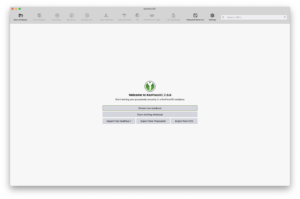

KEEPASSXC VERIFY MAC WINDOWS 10
Unfortunately the version of SSH client that comes with Windows 10 before version 21H1 is buggy and doesn't work with RSA keys (this has been patched in 21H1). Set its Startup type to Automatic, apply and start it. Open services.msc and find OpenSSH Authentication Agent. You also have to enable the agent's service. If that's not the case, you have to reorder your PATH entries. Typing where ssh-add in the cmd window should return C:\Windows\System32\OpenSSH\ssh-add.exe as the first entry. If you have another SSH client installed (for example the one that comes with git), make sure that the Windows one is used on the command line. Make sure you have OpenSSH Client component installed (it's optional - may be missing if you've removed it explicitly or upgraded from an older version of Windows). It's a bit different than "bare" OpenSSH when it comes to communication with the agent. WindowsĪnswer tested on Windows 10 version 2004.įirst of all, you have to be using the OpenSSH Client that comes with Windows 10. If you're on Pop!_OS and apt installs an older version than snap, see this question: KeePassXC is not upgrading to latest version on Pop!_OS.
KEEPASSXC VERIFY MAC INSTALL
If snap info keepassxc returns something, you must remove the snap version and install a regular one using apt. SSH Agent does not work if KeePassXC is installed as a snap package. Use ssh-add -l to check if your keys are loaded (if you've chosen to add them manually, you can do this by right-clicking them and selecting Add key to SSH Agent). This feature should mostly work out of the box, just enable it in KeePassXC settings. I've tested this on Pop!_OS 18.04, which is a closely related fork of Ubuntu. Choose your private key from attachments or the filesystem.īrowser Integration tab: Check Hide this entry from the browser extension.

SSH Agent tab: Configure when the key is added and removed to your liking.
KEEPASSXC VERIFY MAC PASSWORD
The password will be used to unlock the key if it's password protected.Īdvanced tab: Add the private key as an attachment if you wish to store it in the database (useful for sharing between systems if your database is already shared somehow).Īuto-Type tab: Uncheck Enable Auto-Type for this entry.

The username will be used as a key name in the agent ( ssh-add -l). See the dedicated section about this problem, its consequences and possible workarounds at the end. One major drawback of this setup is that on Windows git won't work with the SSH agent. You can also set timeouts for key removal and enable confirmations on per-key basis. Keys can be added and removed on demand or automatically when the database is opened/closed. Alternatively, you can keep password-protected key files in the filesystem and use KeePassXC to unlock them automatically using a password stored in the DB and insert them into agent. Private keys can be stored entirely in a KeePassXC database. Instead, it communicates with an already running SSH agent and adds or removes SSH keys as needed. KeePassXC doesn't act as a full-blown SSH agent replacement. It's probably best to read it whole to get a general idea of how it works. The SSH Agent has a whole dedicated section in KeePassXC docs.


 0 kommentar(er)
0 kommentar(er)
